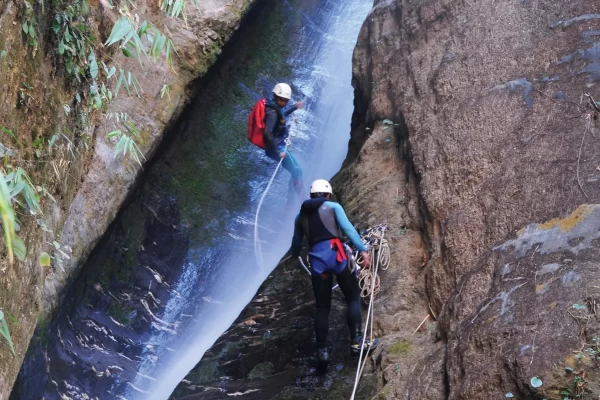Canyoning - An Emerging Adventure Sport of Waterfalls

It is said that adventurous activities like canyoning relieve stress and anxiety. The cold currents of the waterfall refresh the body, that is why in countries such as Europe, Asia, South America, and the USA, it is also branded as ‘Adventure Healing’ sports. Nepal also has immense opportunities to develop canyoning as a sport. A nation filled with waterfalls, Nepal could easily be identified as the ‘Nation of Adventure Canyoning’. In Nepali, canyoning is known as ‘Chhango Barwohan’. Just like mountaineering is the act of climbing from the bottom of the mountain to the top; Canyoning is the act of descending from the top of a waterfall (Chhanga) to the bottom. However, in Nepal, people are more used to the English term, ‘canyoning ’.
Canyoning takes a lot of courage, patience, and moral conscience. It is not for the faint-hearted. This sport requires abseiling from the top of a waterfall, abseiling, sliding on rocks, and finally jumping into the water below. It is done by an anchor which is placed into a rock at the top of the waterfall where a rope is connected. A person needs to grab the rope and descend the waterfall under the instructions of the canyoning guide. To go canyoning, one requires a special wet suit which needs to be worn by the adventurer. Along with this, they need to wear a helmet, specially designed Canyoning shoes, bags, rope, canyoning gears, and static or semi-static ropes. They also need to wear a harness which helps to lock in the rope while on one hand a lock will be placed which the canyoner can use to control the descent’s speed. Before setting your foot on the top of the waterfall, the participants are instructed by the guides and this helps to build confidence as you grab the rope and begin descending. However, once the thrill of the adventure starts, you’ll feel as if you’ve reached the bottom too quickly!
To promote canyoning in Nepal, the Nepal Canyoning Association (NCA) has already started exploring the possibility of canyoning in Nepal’s four dozen waterfalls. Currently, you can find professional canyoning in different places such as Kathmandu’s Sundarijal, Nuwakot ’s Kakani, Thanapati- San Chhahare, Kavre ’s Bandiba Khola, and Tangtung Khola- Temal Kallery, Kaski’s Lwang and Ghalel, Sindhupalchok ’s Bhotekoshi- Jambu, Kavre, Haadi, Galung, Fyangfung, Chitwan- Jalbire and Dhankuta ’s Namaste Waterfall. Other regions that offer waterfalls include Syangja, Manang, Dhading, Okhaldunga, and Parbat. Nepal also has other waterfalls that could gain international recognition for canyoning. The world’s longest waterfall (2000 meters) is located in Lamjung ’s Marshyangdi valley whereas the world’s highest altitude waterfall (5215 meters) is located in Manag Phu village on the Lungaa River.
According to estimates, roughly 10,000 people went canyoning in Nepal each year before the Covid-19 pandemic. Out of them, only a thousand were international tourists while the rest were domestic. Nepal Canyoning Association (NCA) was established in 2007, since then, it has the ability to lead by professional canyoning guides. Before that, canyoning was only done by independent individuals but it appears to have taken a commercial form since 2005.
Currently, in Nepal, there are about 45 canyoning guides. Some of the popular guides include Rajesh Lama, Kabindra Lama, Kishor Shahi, Dabindra Tamang, Min Magar, Bhakta Biswokarma, Ratna Tamang, Basu Gautam, Antim Gurung, Babi, Santosh Rana, and Anu Shrestha. These guides have traveled to countries such as Japan and other places to train and practice the art of canyoning and rafting. Even foreign individuals have teamed up with the Nepali guides to promote canyoning in Nepal such as American Instructor Rich Carlson and French citizen Maurice Duchene.
You may also like: Flying with the Balloons in Nepal- Hot Air Balloon Adventure
Although canyoning has the potential to thrive in Nepal’s central hilly region, the Nepalese government has not committed to promoting the sport. Several issues related to the policy, and the registrations have made it an inconvenience. Another issue is that the government has not been able to recognize the importance of canyoning as a thrilling adventure sport in Nepal.
According to Rajendra B. Lama, the current president of the Nepal Canyoning Association, the government has not yet been able to create tourism-friendly policies and rules. Also, it did not allocate the budget to develop and brand the canyoning product and skill development.Canyoning is a year-round (For All Seasons) activity in Nepal, which if explored could become a lucrative sport. During the rainy season, only expert canyoners are permitted to participate, however, during other seasons, there is no restriction to canyoning!
Tips For Canyoning
- Rajendra Lama
-
Carry necessary apparel and toiletries like towels, sports shoes, comfortable trousers, sandals, caps, and other items as needed.
-
Only carry the essentials and if possible, do not carry valuables such as watches and jewelry.
-
While canyoning can be done by people aged from 6 to 75, people who have injuries, cardiac patients, and people with back pain should not do canyoning as the fast-flowing water can cause additional health issues.
-
Canyoning should not be done while under the influence of alcohol.
-
It is necessary to strictly follow the guide’s instructions
-
Descend from the rope slowly and steadily.
- Work together as a group. Don’t flaunt yourself.
Canyoning Package
In Nepal, more than 20 organizations offer canyoning packages. One-day package for canyoning is rated at NRs 5500 for locals and USD 150 for foreigners, the prices include traveling up to the canyoning location, food, and equipment. In the context of Nepalese, there needs to be a group of 10 people while for overseas nationals, a group of 4 people is required. Further information related to canyoning can be retrieved from Nepal Canyoning Association.
